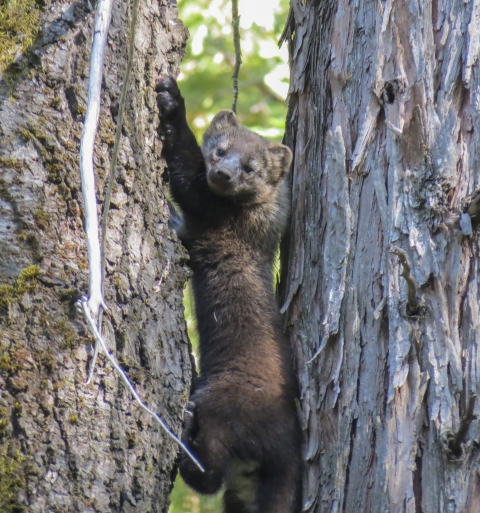A cat-sized fisher huddles in the back of a trap box at the bottom of a forested ravine. When a handheld receiver passes over the box, there’s a beeping noise - this fisher has an implanted microchip from a recent capture. As the trap door lifts, representatives from the U.S. Fish and Wildlife Service, California Department of Fish and Wildlife, Oregon State University and Sierra Pacific Industries gather nearby, cameras poised in hopes of catching a glimpse of the sleek, brown 2-year-old female as she vanishes into the woods.
This scene played out on the Sierra Pacific-owned Stirling Management Area east of Chico, California, almost three years ago, as a decade-long fisher translocation project came to a successful conclusion. Due to the collaborative conservation efforts for Pacific fishers (Pekania pennanti) in this range, the Service has been able to keep the northern California and southern Oregon population from being listed under the Endangered Species Act.
The Service recently praised the relationship between science, conservation and partnerships, recognizing that private landowners and academic researchers are a crucial part of the fisher success story.
“We’re grateful for the work of our partners to retain and provide habitat for the fisher,” said Paul Souza, regional director for the Service’s California-Great Basin Region. “Their efforts are critical to the health and resilience of fishers in northern California and southern Oregon.”
In addition to the partnership with Sierra Pacific, similar agreements are in place or being developed between federal, state and private timber owners to protect existing and provide additional fisher habitat in the northern part of their range. In Oregon, over two million acres of private land protect fisher and their young by limiting disturbance and impacts to denning and resting sites. These agreements also promote development of habitat structures (snags and slash piles) that will support fisher populations.
“Voluntary conservation efforts with timberland owners have contributed to the stability of these northern fishers,” said Paul Henson, state supervisor for the Service’s Oregon fish and wildlife office. “The heavy lifting done by our partners greatly alleviates the need for federal regulation on this population of fishers.”
Additionally, the USDA Forest Service and several private timber companies in California and Oregon committed to reducing the risk of catastrophic wildfire while conserving fisher habitat.
“Fisher populations should benefit from these collaborations,” said Barnie Gyant, Deputy Regional Forester of the Forest Service’s Pacific Southwest Region. “By working together, we can make a difference for this species throughout their range.”
Fishers are members of the weasel family, often described as a mishmash of wolverine, bear, otter and squirrel. Their fur is dark to blackish brown, with irregular white patches on the throat and belly. While they prefer a meal of gray squirrel, fishers are known to eat just about anything smaller than them.
Preferred fisher habitat is old-growth forests dominated by large, older trees with cavities for denning and resting. Such habitat is found from Crater Lake National Park in Oregon to Chico, California, and along the coast from southern Oregon to near Point Reyes National Park in California.
Historically, fishers ranged from the southern Sierra Nevada to British Columbia, but over-trapping and loss of habitat drastically reduced their numbers. Even though California prohibited trapping of fishers in 1946, their population continued downward. As a result, fishers along the West Coast have been proposed for ESA protection off and on since the early 2000s. The most recent proposal to list this population as threatened occurred in late 2019.
During an extensive review of scientific information and numerous public comments, it was determined that two distinct populations of West Coast fisher existed: the Northern California-Southern Oregon and the Southern Sierra Nevada Distinct Population Segments. Not only are these two populations genetically different, they are separated by 130 miles of California’s Central Valley, making it extremely unlikely fishers from either population would ever cross paths.
Threats to fishers in each population are similar: loss of habitat, severe wildfire, climate change climate change
Climate change includes both global warming driven by human-induced emissions of greenhouse gases and the resulting large-scale shifts in weather patterns. Though there have been previous periods of climatic change, since the mid-20th century humans have had an unprecedented impact on Earth's climate system and caused change on a global scale.
Learn more about climate change , predation and effects of toxicants. Because the northern California-southern Oregon fisher population is larger, around 3,100 individuals, it is more widely distributed. Reintroduction efforts like the Stirling project and other partner conservation measures have helped them to remain more stable within their range.
“Partnerships between private timberland owners and agencies demonstrates productive forestry can operate in a manner that protects and restores habitat for important species such as the fisher,” said Richard Gordon, President and CEO of California Forestry Association. “Today, stewardship of habitat is part of the DNA of active forest management and California’s forest landowners.”
For the fishers in the southern Sierra Nevada, survival is more of a challenge. In 2017, a catastrophic wildfire resulted in a significant loss of fisher habitat. Based on this as well as threats mentioned above, collisions with vehicles and a small population, an estimated 100 – 500 in the wild, this group of fishers was listed as endangered under the ESA.
Conservation efforts for this fisher population falls to the Southern Sierra Nevada Fisher Conservation Strategy, a collaborative group of federal, state, tribal and private entities with an interest in fisher conservation and land management. The strategy provides science-based guidance for conserving and recovering fisher by reducing threats and increasing the quality and resiliency of fisher habitat in the southern Sierra Nevada.
“Collaborative conservation partnerships play a critical role in maintaining habitat connectivity for fisher in both populations,” said Jenny Ericson, field supervisor for the Service’s Yreka Fish and Wildlife office. “From state and federal agencies to small family forests and large commercial holdings, all are important to the health and viability of wide-ranging species like fisher.”









